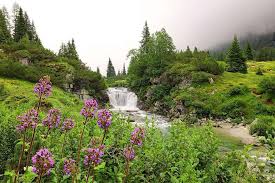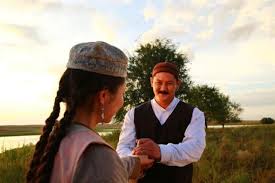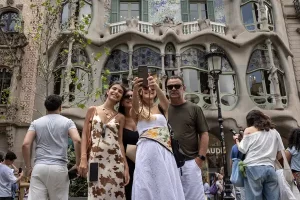Italy: Spending time in Trentino among wildflowers

Trentino: The last slip of Lake Garda has not long disappeared from the rearview mirror before flowers – copious and colourful – are diverting my attention from the road. Despite a packed schedule of floral hikes beginning early the next morning, I can’t even make it to my hotel without first wading waste-deep into a meadow, its daisies and salvia glowing with sunset.
The swift hour and a half drive from Verona Airport has been rife with temptation. First the drifts of blue echium lining the civic roads and motorway (but where to stop? Too late!) next the metallic hills and green views of Trentino’s vineyards and surrounding beech woods. Entering the Unesco-protected Ledro Valley, rounding cool-blue Lake Ledro itself and ascending towards the village of Lenzumo, I’m in my element and have to pull over. The flower meadow, I’ll learn across the next three days, is merely commonplace here, a springtime staple of Valle di Ledro.
Together with the neighbouring province of South Tyrol, Trentino forms Italy’s northernmost region, a biodiverse landscape of forests, grasslands and lakes, overlooked by the Dolomites and magnificent central Alps. It is also one of the youngest, having only since the First World War formally joined the country. Prior to annexation Trentino was predominantly German-speaking. As the mountainous terrain became the Italian front line against Austria-Hungary, rural communities were divided by enlistment and evacuation, leaving towns and villages to be requisitioned by the military. Those returning after the war found their homeland dramatically altered by Mussolini’s programme of ‘Italianisation’, under which Trentino was forced to abandon much of its Austrian heritage. Roots ran deep however, and today the province feels in character both Italian and ‘Alpine-Austrian’, adding to the region’s unique sense of identity.
Lenzumo, where I am staying, very much reflects this cultural duality. While the architecture marries crumbling stucco plaster with wooden ski-chalet roofs, its inhabitants appear rooted in the landscape: farmers, agro-foresters, wine-makers. In the local osteria the barista serves your macchiato with a weather-worn collie dozing at his feet. My hotel, Da Elda Natural Retreat, is a family run business. While host Sylvia Pregl shows me up to my room, her brother Antoine is busy in the restaurant kitchen, enlivening his set menu with locally gathered herbs. Da Elda sets the perfect tone for a long weekend’s flower hunt. It is bright with natural light, eco-minded, and plenty of glass lets in the stunning countryside. At night a tawny owl nearby maintains a placid hoot, right on cue.
In the morning I’m met by local guide Lorenzo Pizzini for the first of the weekend’s Valle di Ledro hikes. Our destination is the Dromaè meadow, a subalpine grassland high above the lake. The Dromaè flora is renowned for two attractive natives: the dainty ‘pheasant’s eye’ daffodil and pink European peony (Paeonia officinalis). ‘You’ve arrived at the perfect time’, Lorenzo offers as we ascend through cool beech woods. ‘Spring has been slow this year but warmer weather has now arrived. We should find peonies but hopefully daffodils also.’ First however, there are jewels below the trees, as an hour’s climb – to an elevation of 1400 metres – reveals forget-me-not, woundwort, violet alpine clematis and many other deep-shade lovers. Above us sunlight perforates newly sprung beech leaves, some of which bear the scarring of unseasonably late frosts.
Emerging from the canopy there is warmth in the air and a spectacle worth the climb. Rolling fields open up ahead, yellow-green in the mid-morning sunshine. Wooden outbuildings perch on the steep calcareous ground. They are rustic but appear well-used. ‘The Dromaè are old cattle fields’, Lorenzo tells me, ‘grazed during the summer months when the lower valley is too hot.’ In the absence of hungry hooves the grass is knee high and studded with two seasons of wild flowers. Erect clumps of mountain cornflower and pink plantain (Plantago media) protrude beside drifts of trefoil and yellow rattle; everything is out at once, including – to my delight – the last of the revered daffodils, their shallow trumpets ringed in a subtle carmine orange. At the field margin in front, where alpine fir trees take over from beech, I spot the bright mauve colour I’ve hoped to find: peonies decorating the clearing. Such is the unending popularity of garden peonies that blowsy cultivars now overshadow a thing of ample and uncomplicated beauty. I hope this single wild form – whose medicinal, diuretic qualities were once sought in these hills – will return to favour, not least for its sweeter scent.
After lunch I follow a winding road north into yet higher ground. The route offers glimpses of snow-peaked ‘Brenta’ Dolomites, and passes meadows of dusky cranesbill and brilliant pink sainfoin. At the little town of Fai della Paganella, looking down to the river Adige and Trento city, I meet mountain guide Samuele Bertò for a walk in the woods. Amid encounters with white helleborine orchids (Cephalanthera damasonium) and blooms of musky cardamine, Samuele explains the region’s tree markings – paint strokes in differing colours indicating Trentino’s many public pathways – and the rising popularity of ‘forest bathing’ in the area.True to Trentino’s diverse character, Valle di Ledro is known for its many differing climatic zones.
Crammed within a comparatively small landmass are varied elevations, aspects and soil cultures, creating environmental niches inhabited by a wide range of plants. One need walk only a short distance to encounter greatly contrasting greenery; spend a whole spring day there and the flowers rapidly number up.
Day two’s roundtrip hike takes in the south western side of the valley, following old cattle-droving paths lined with butterbur and wild aquilegia, along streams, sunny juniper glades and globe-buttercup laden fields. Approaching an expanse of meadow we hear clanging cowbells and catch sight of a small herd meandering over un-grazed green, moving towards a farmhouse and scattered outbuildings. Their owners are engaged in erecting temporary seasonal fences. Passing beside the farm we’re greeted cheerfully by a family just arrived for the summer; encouraged to stop for tea, given homemade cheese, even offered lunch. The scene will remain a lasting memory of Trentino: a landscape of wild flora, fresh food and warmhearted people.





